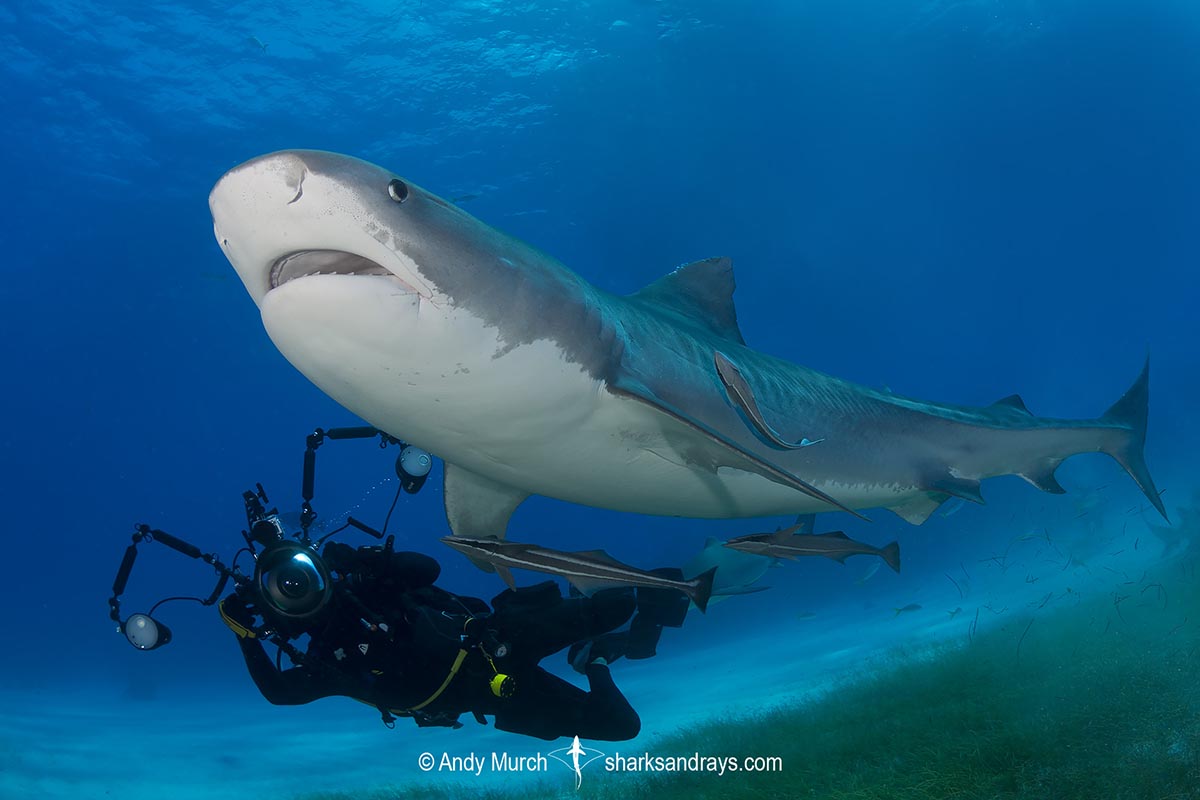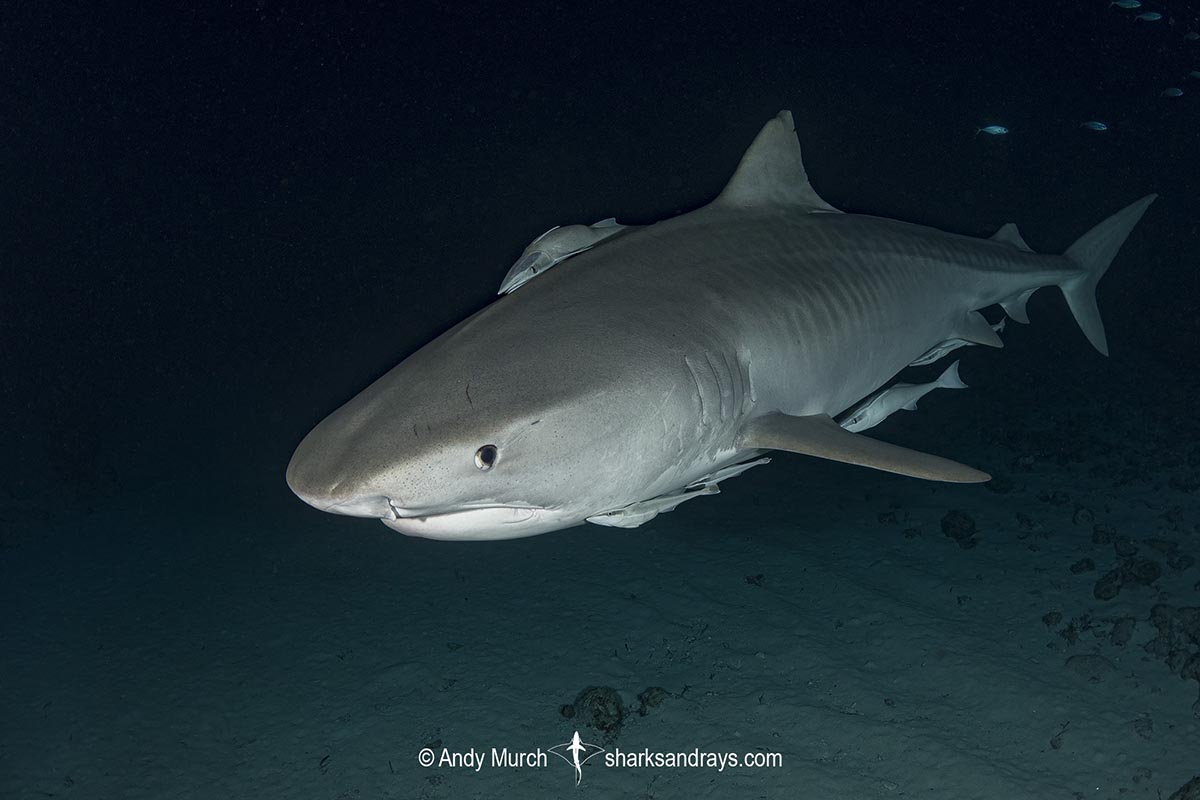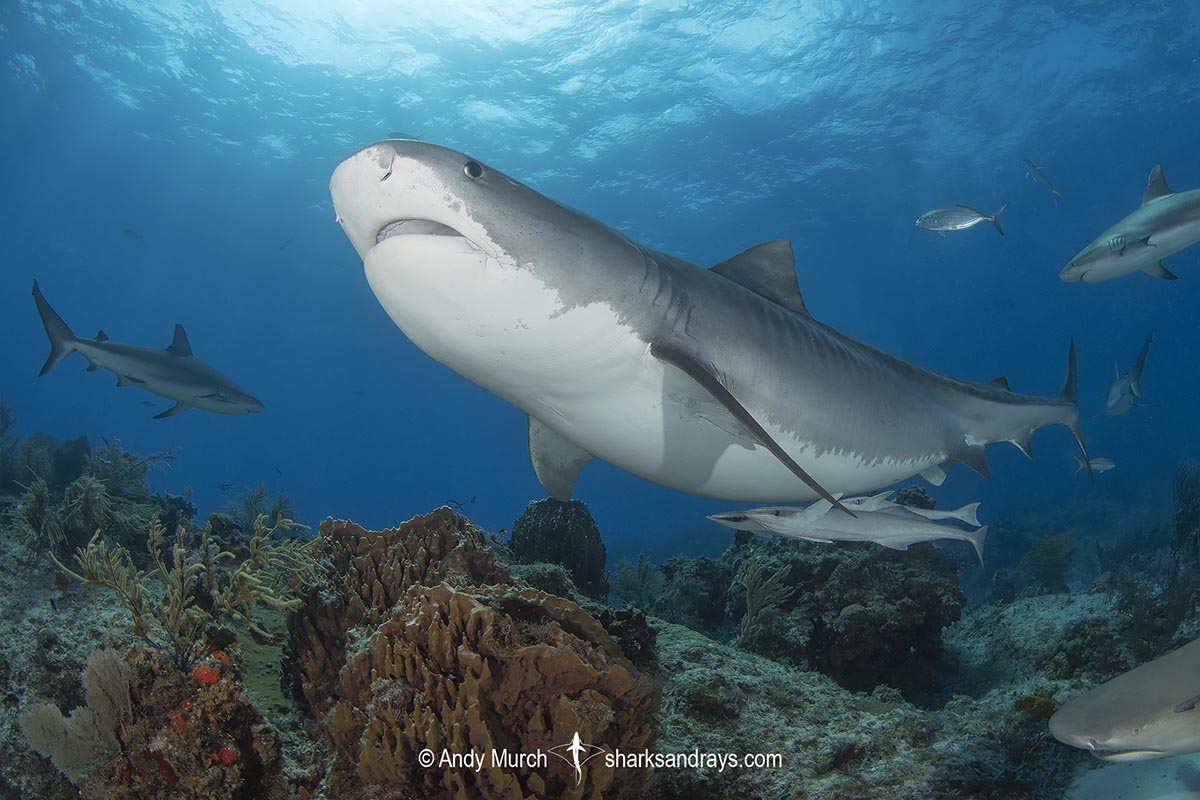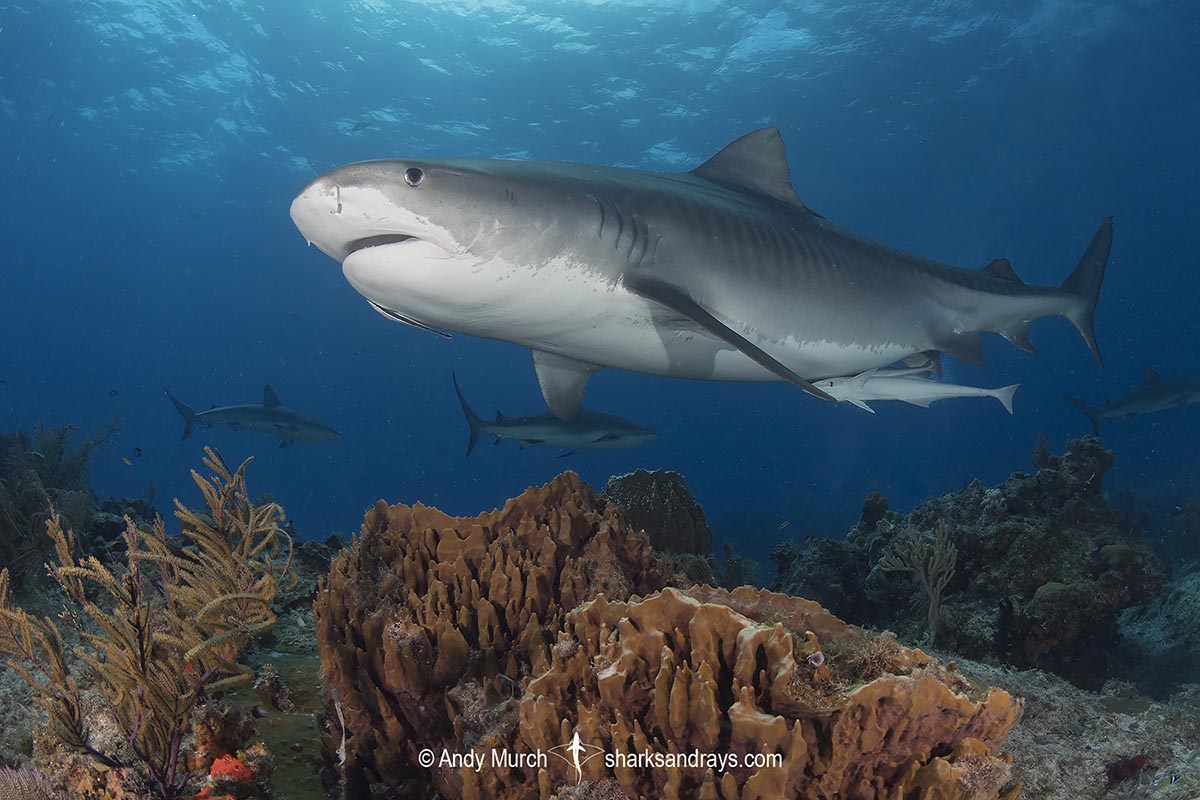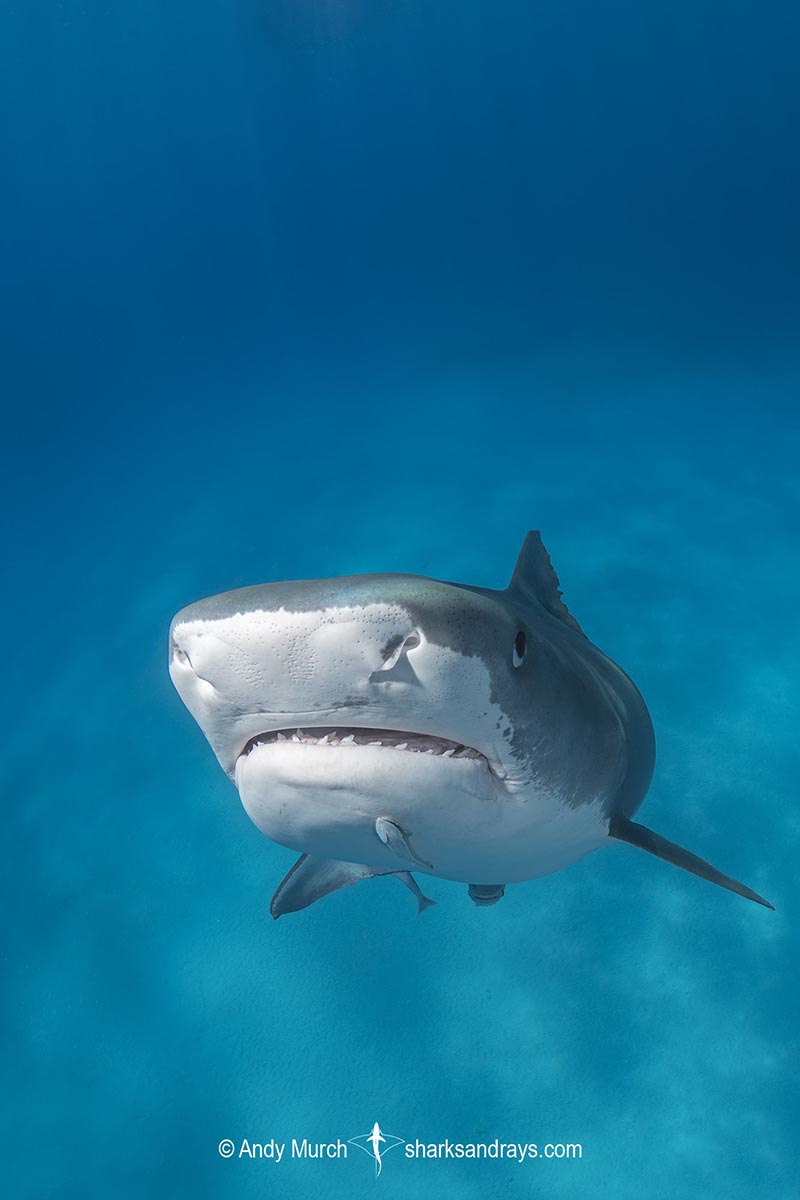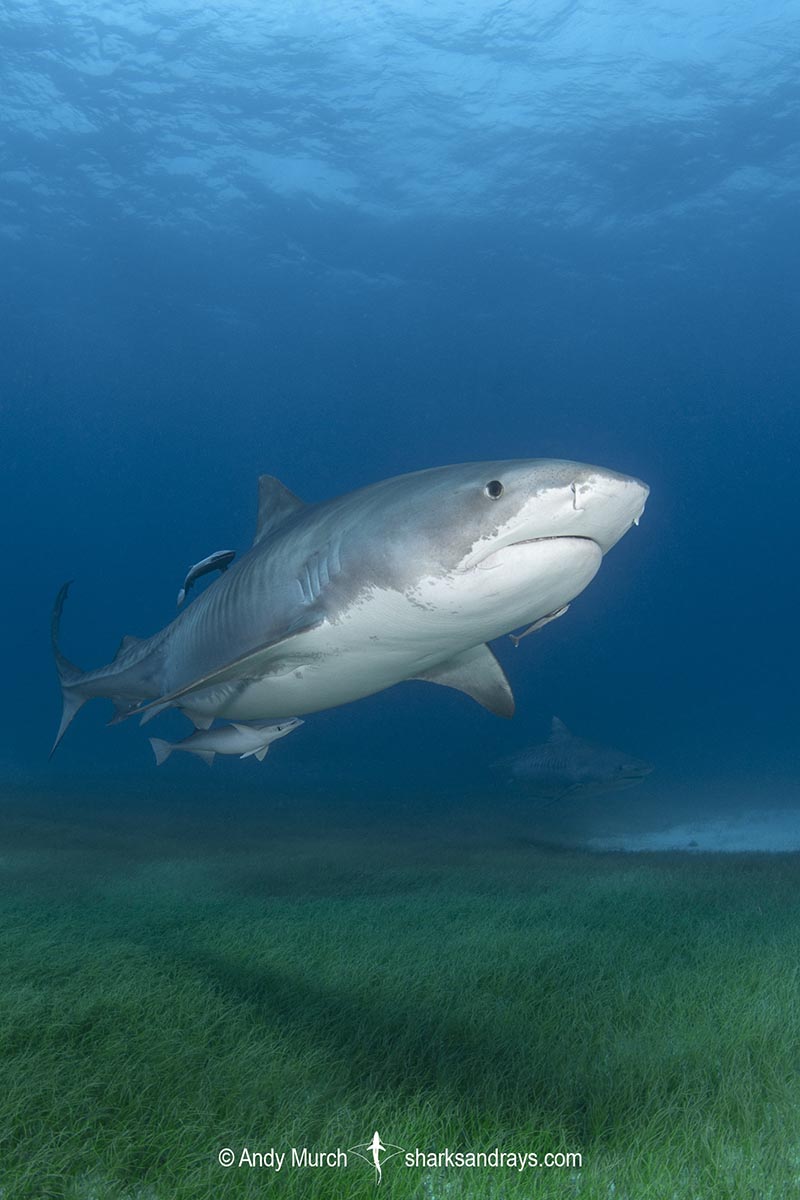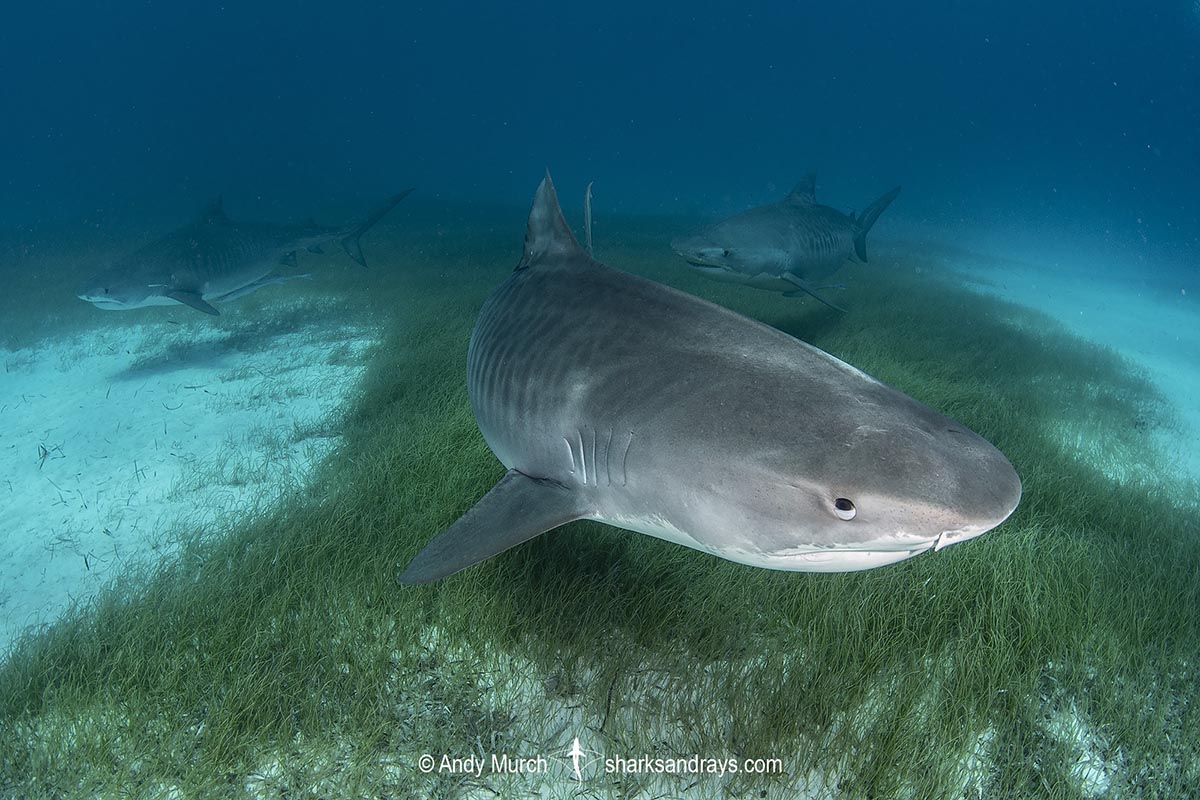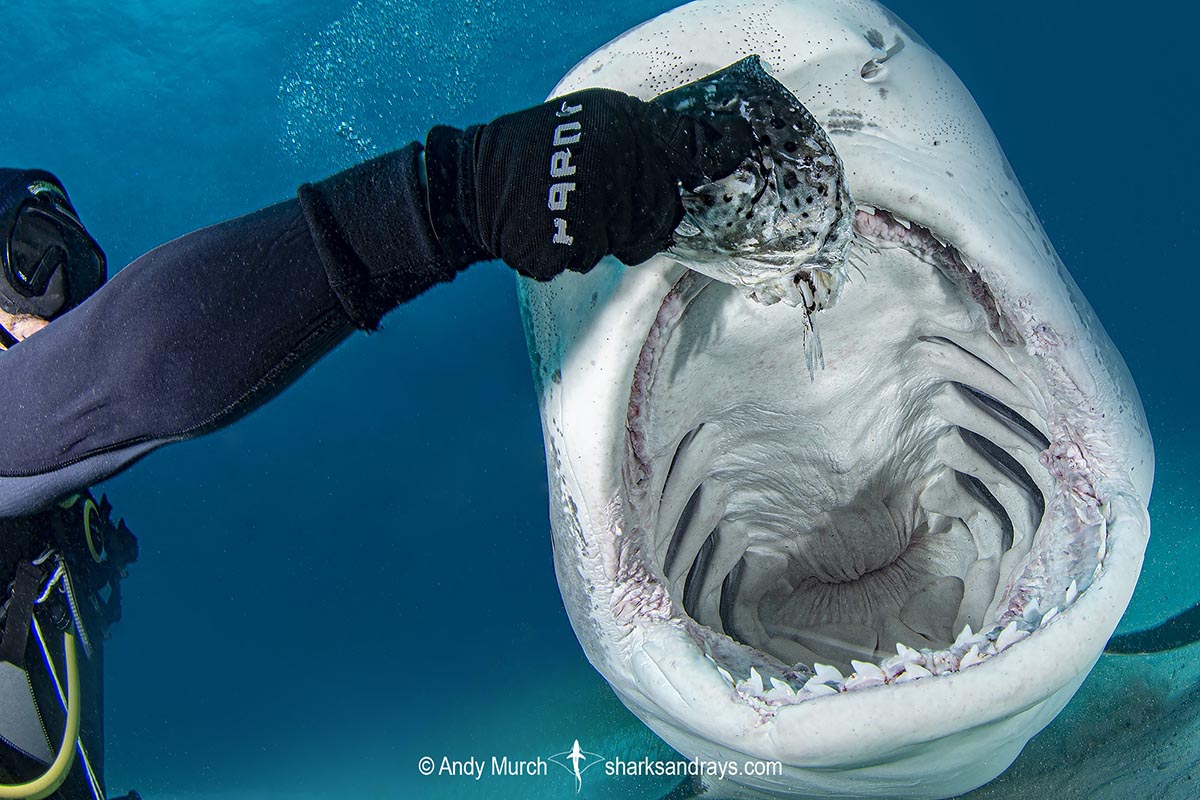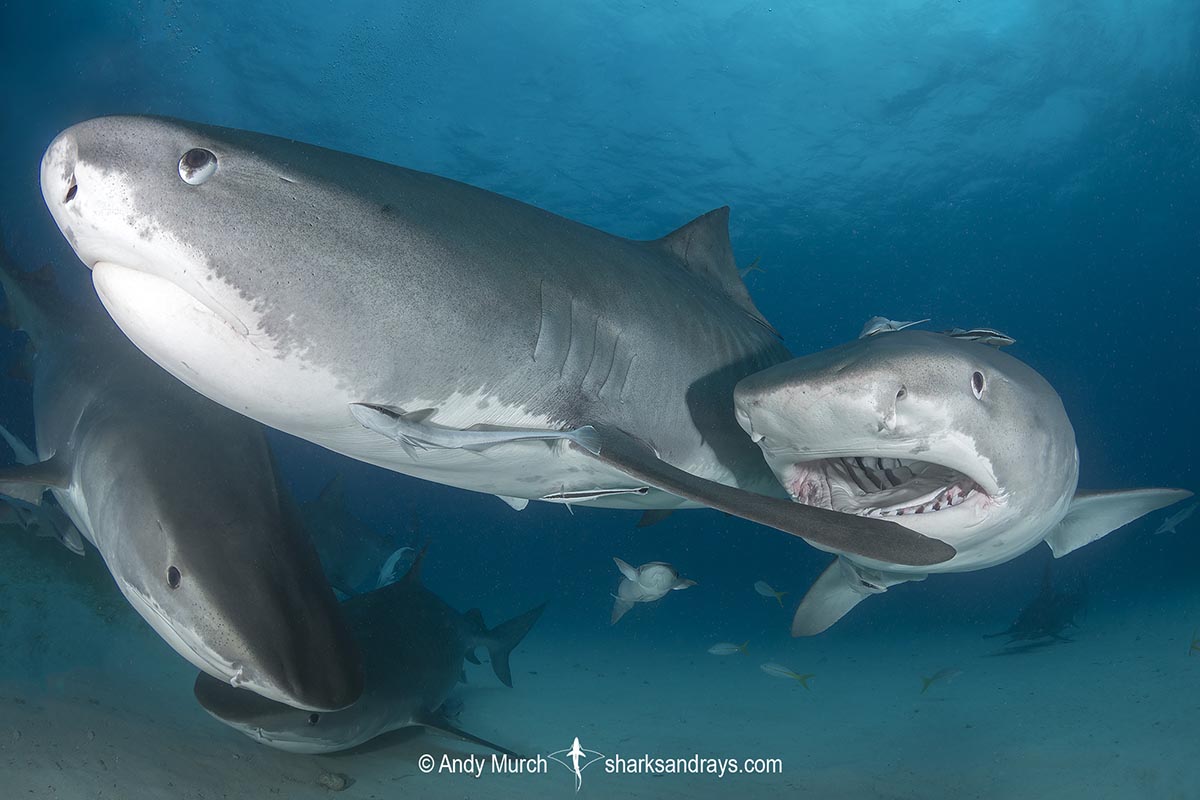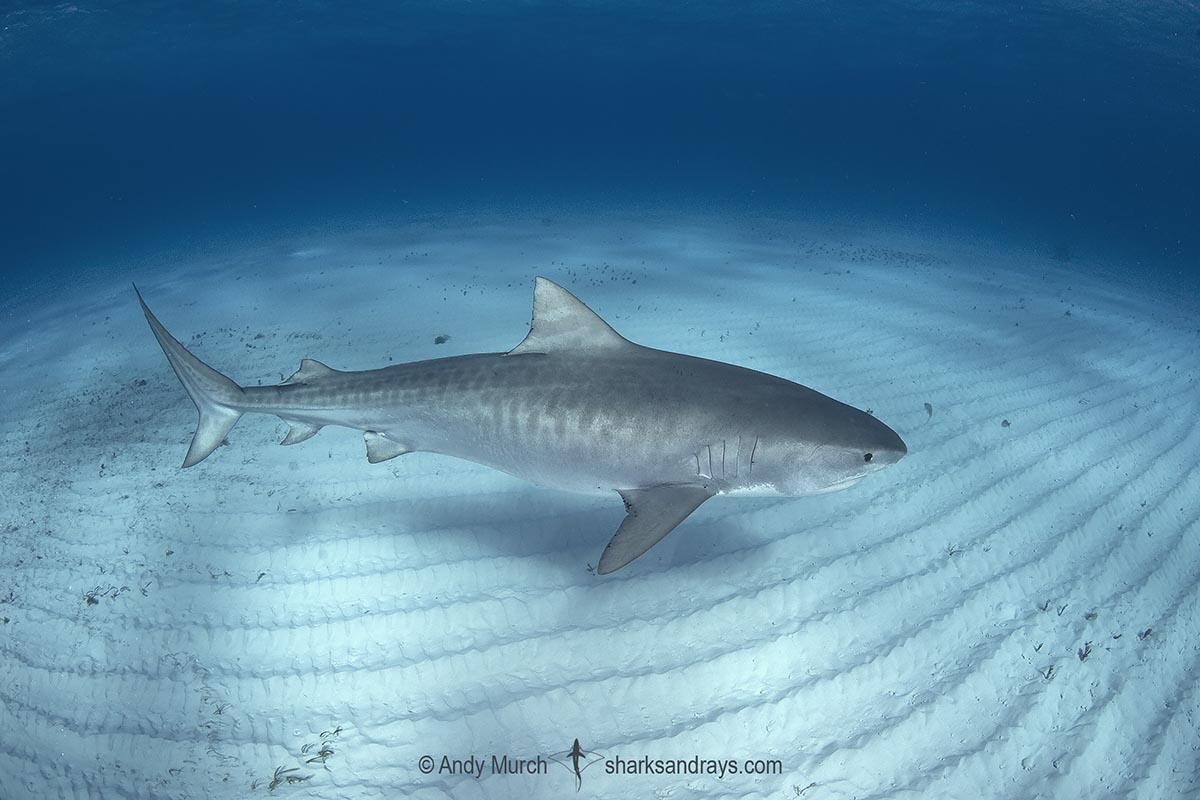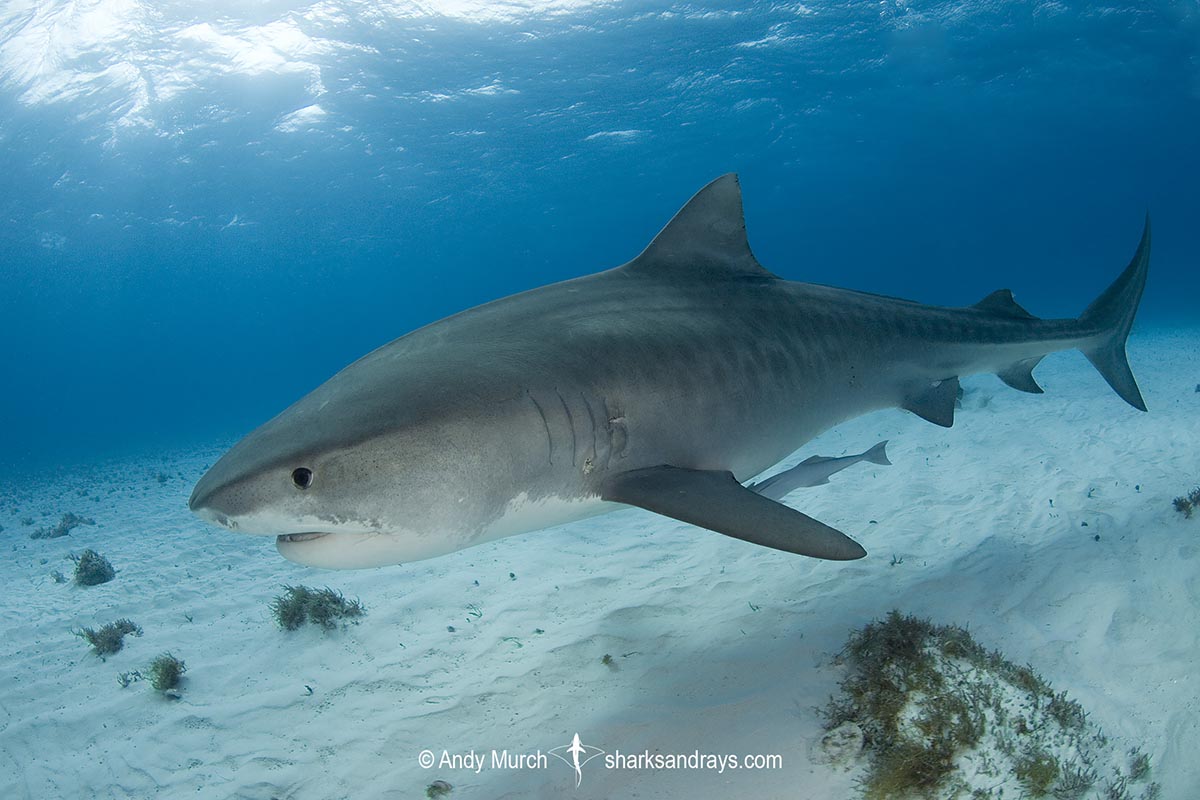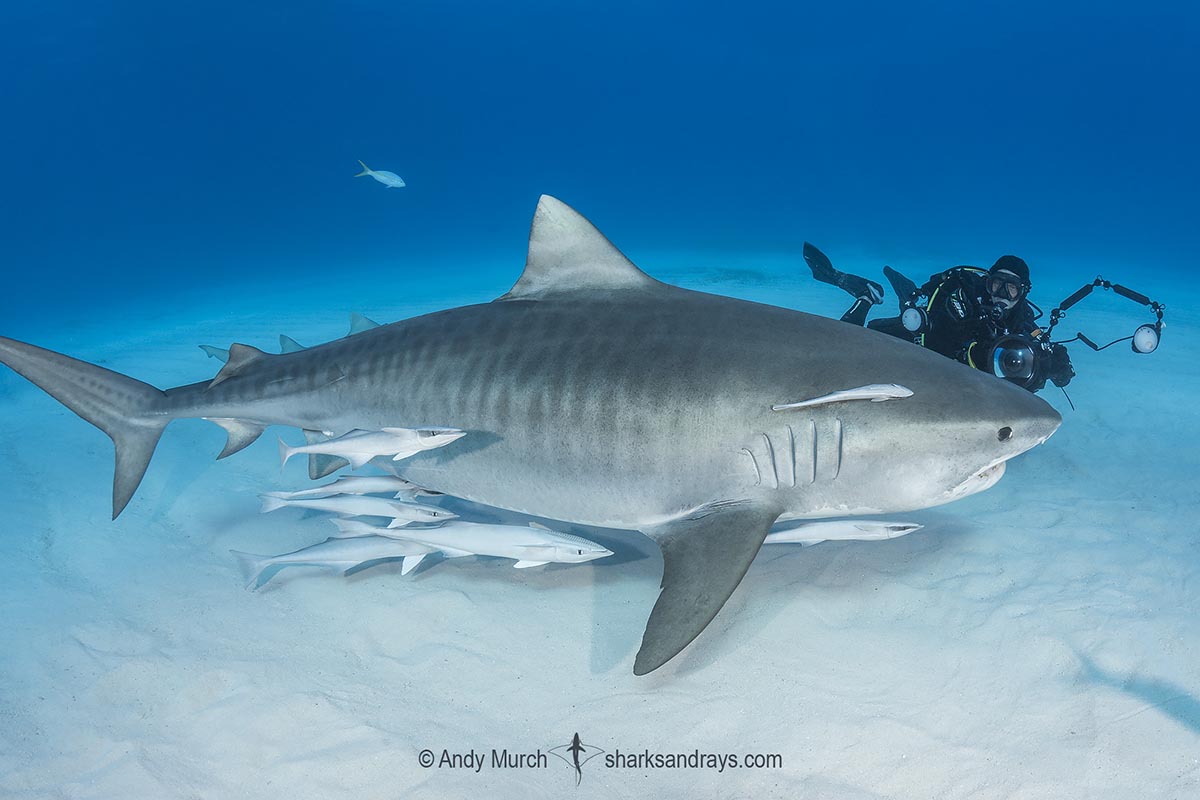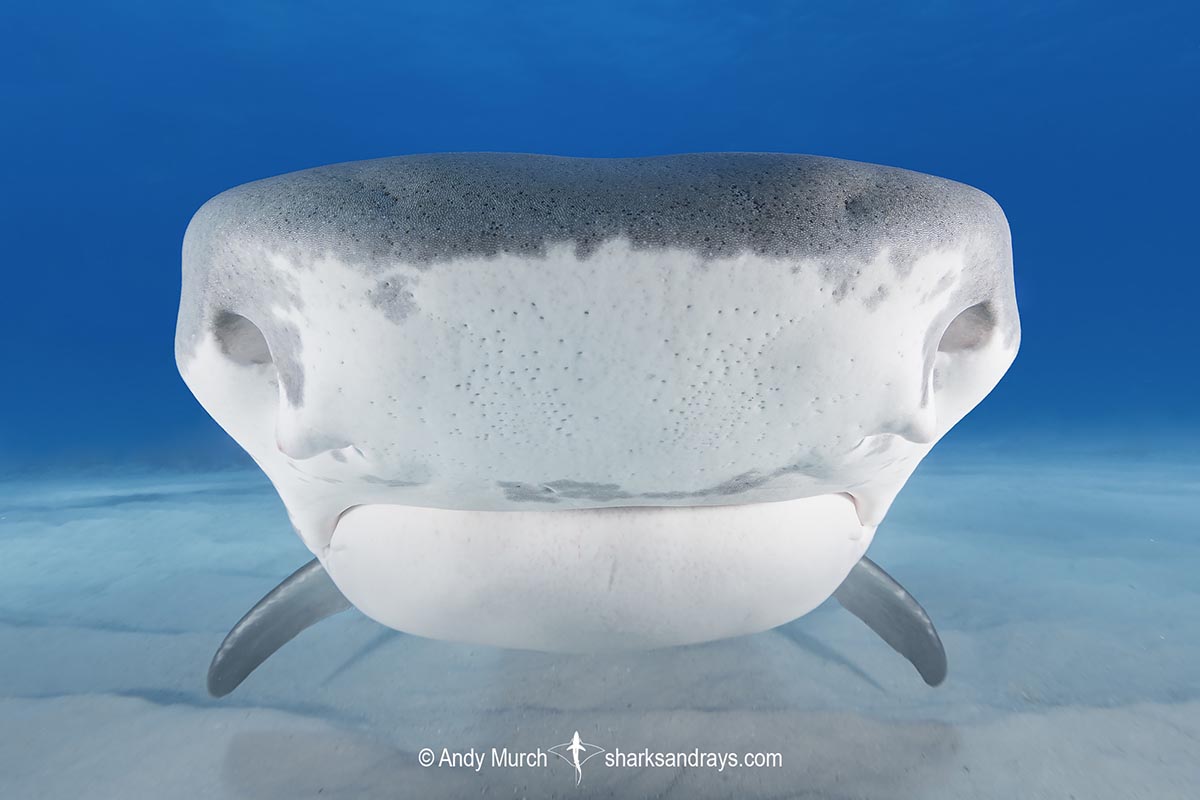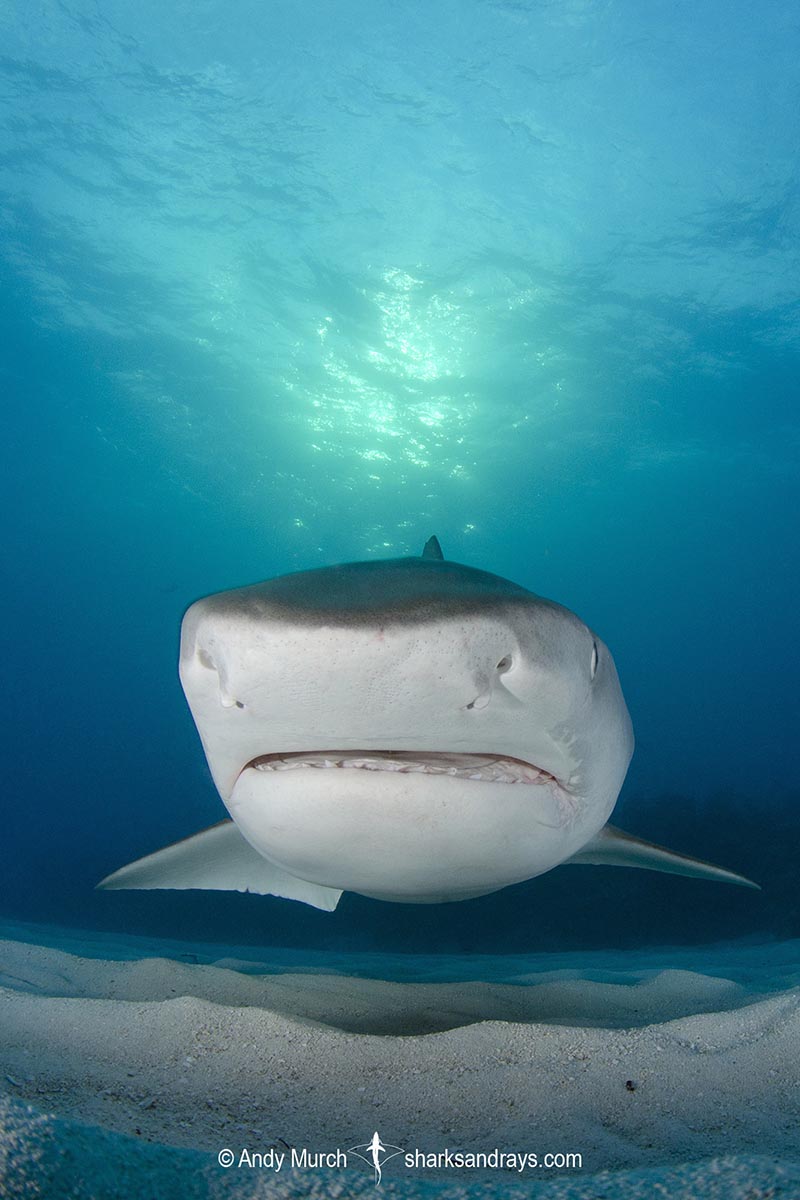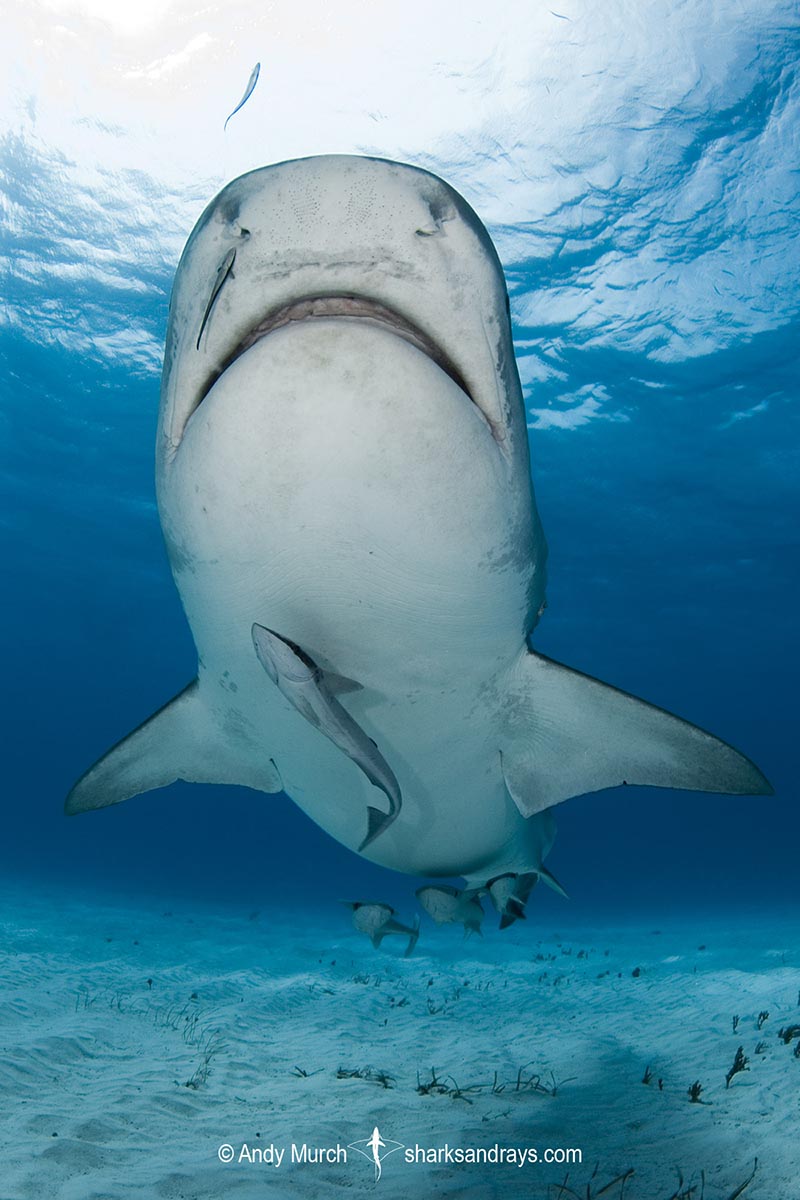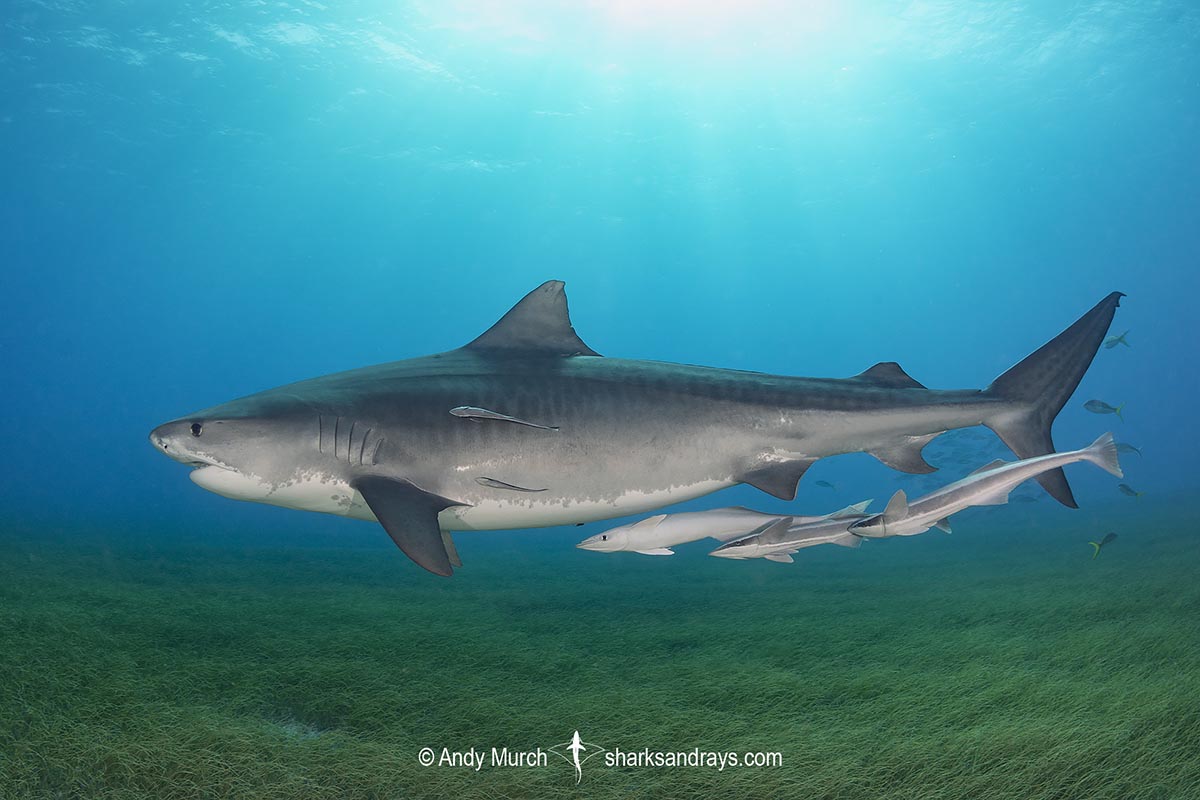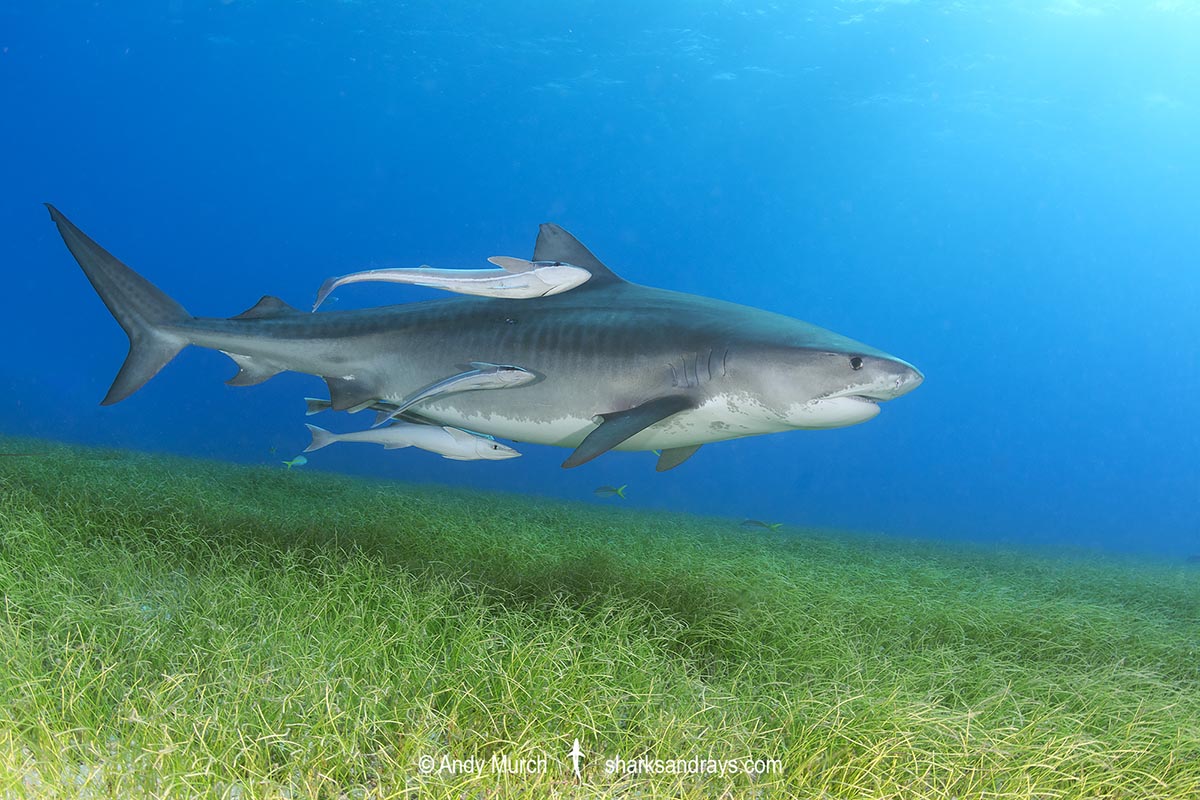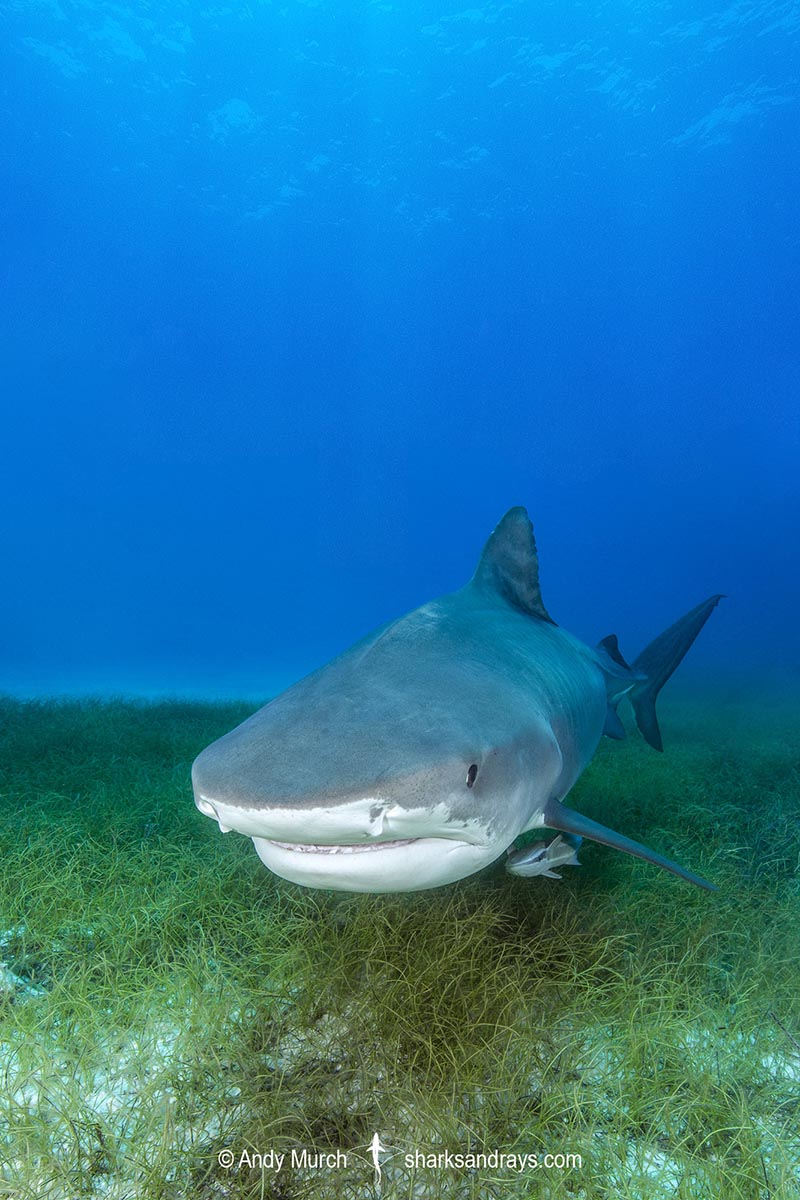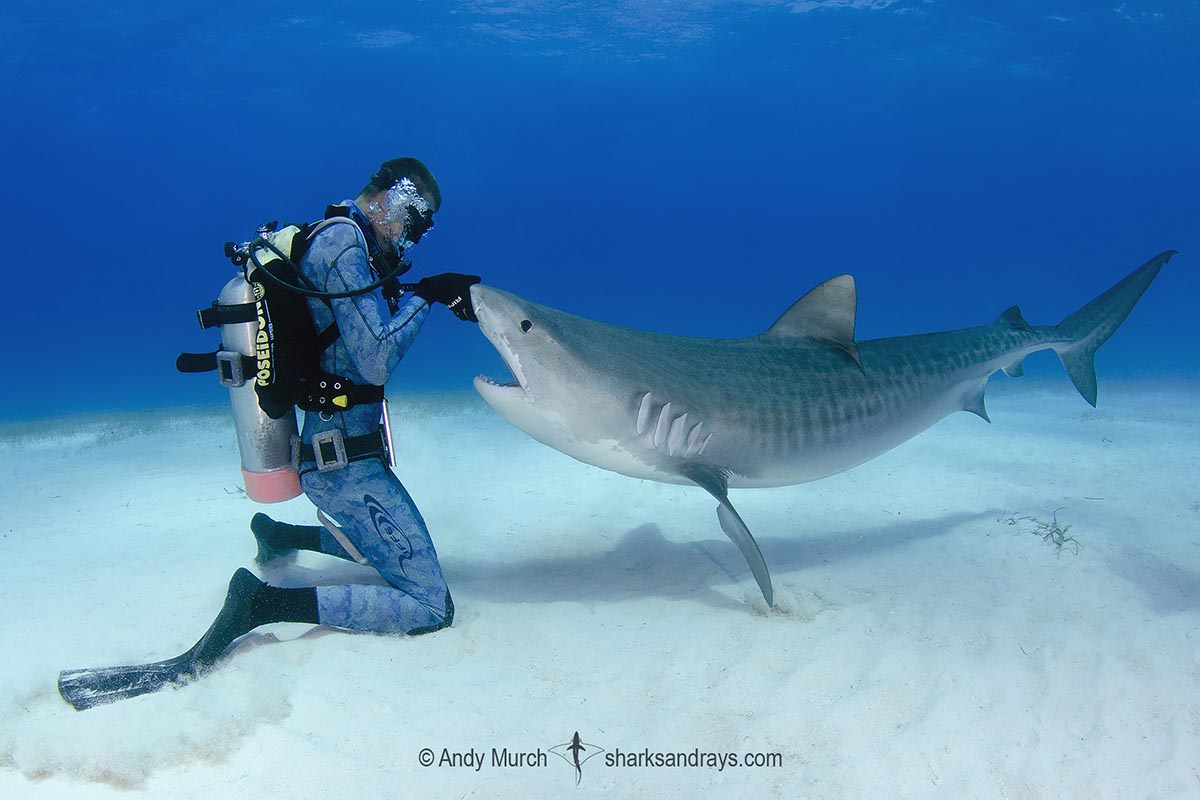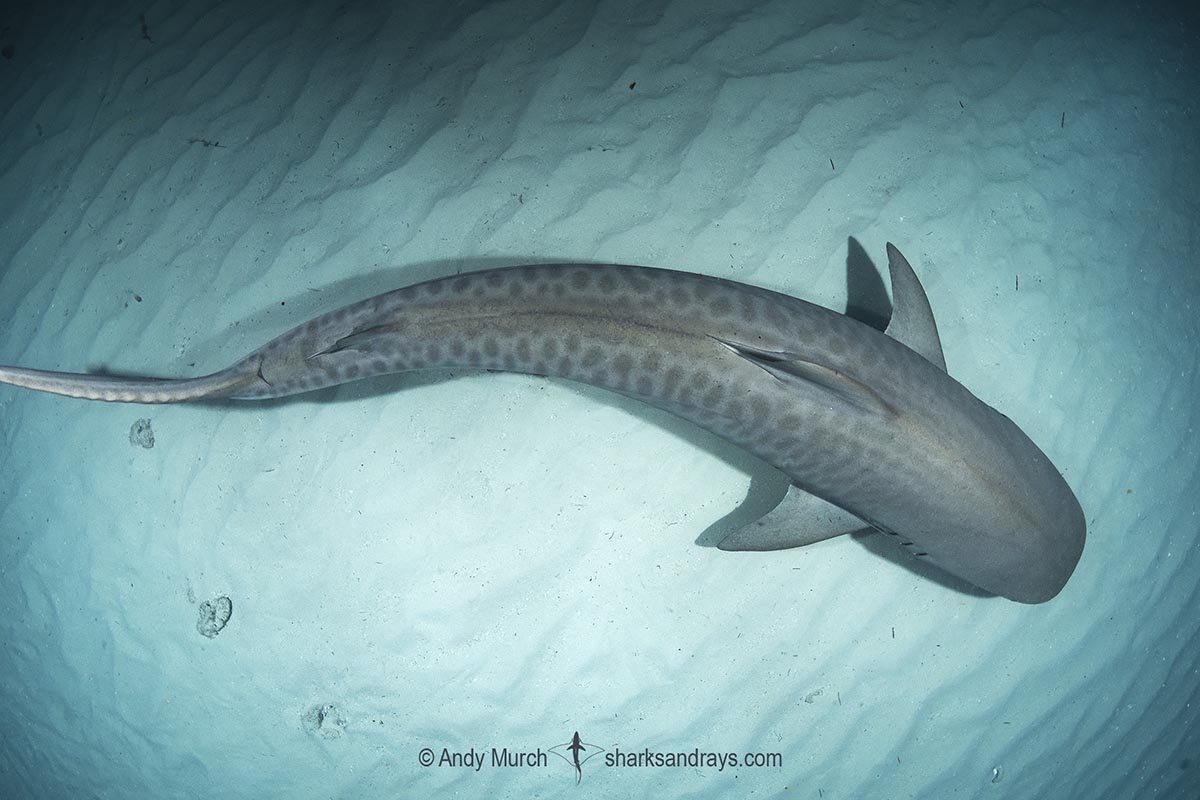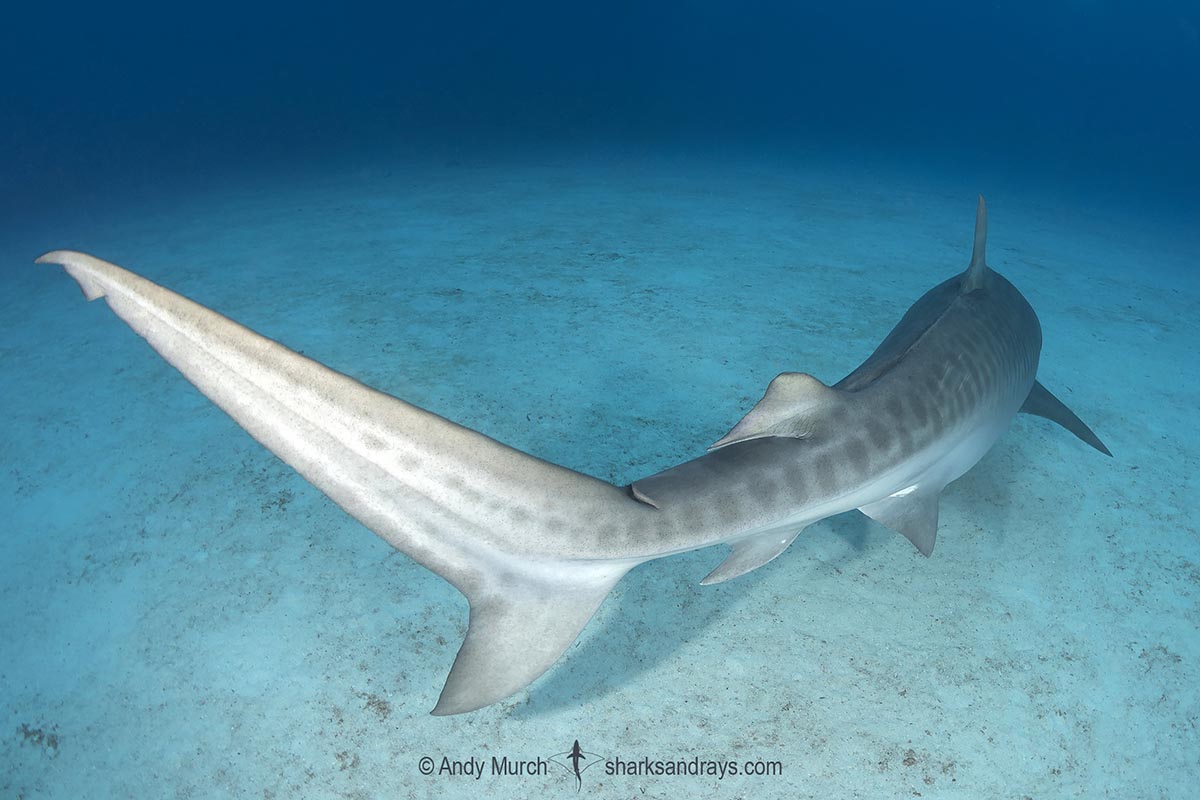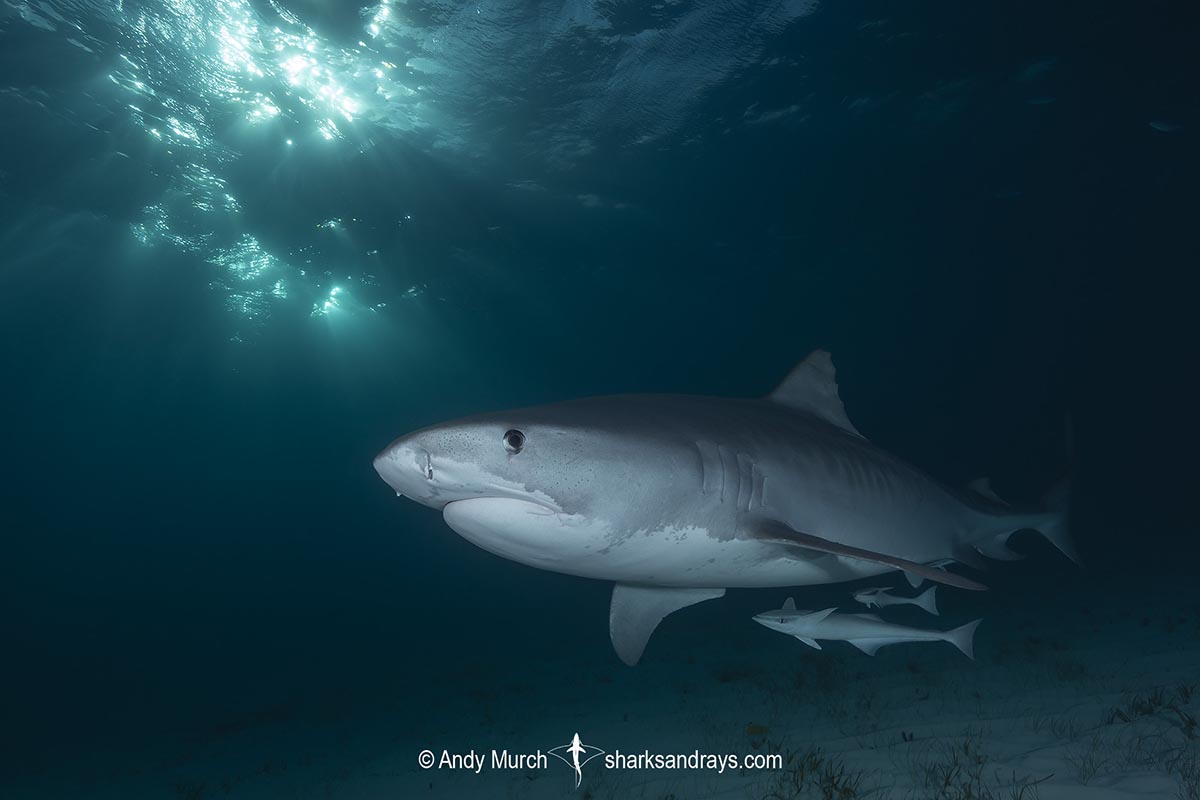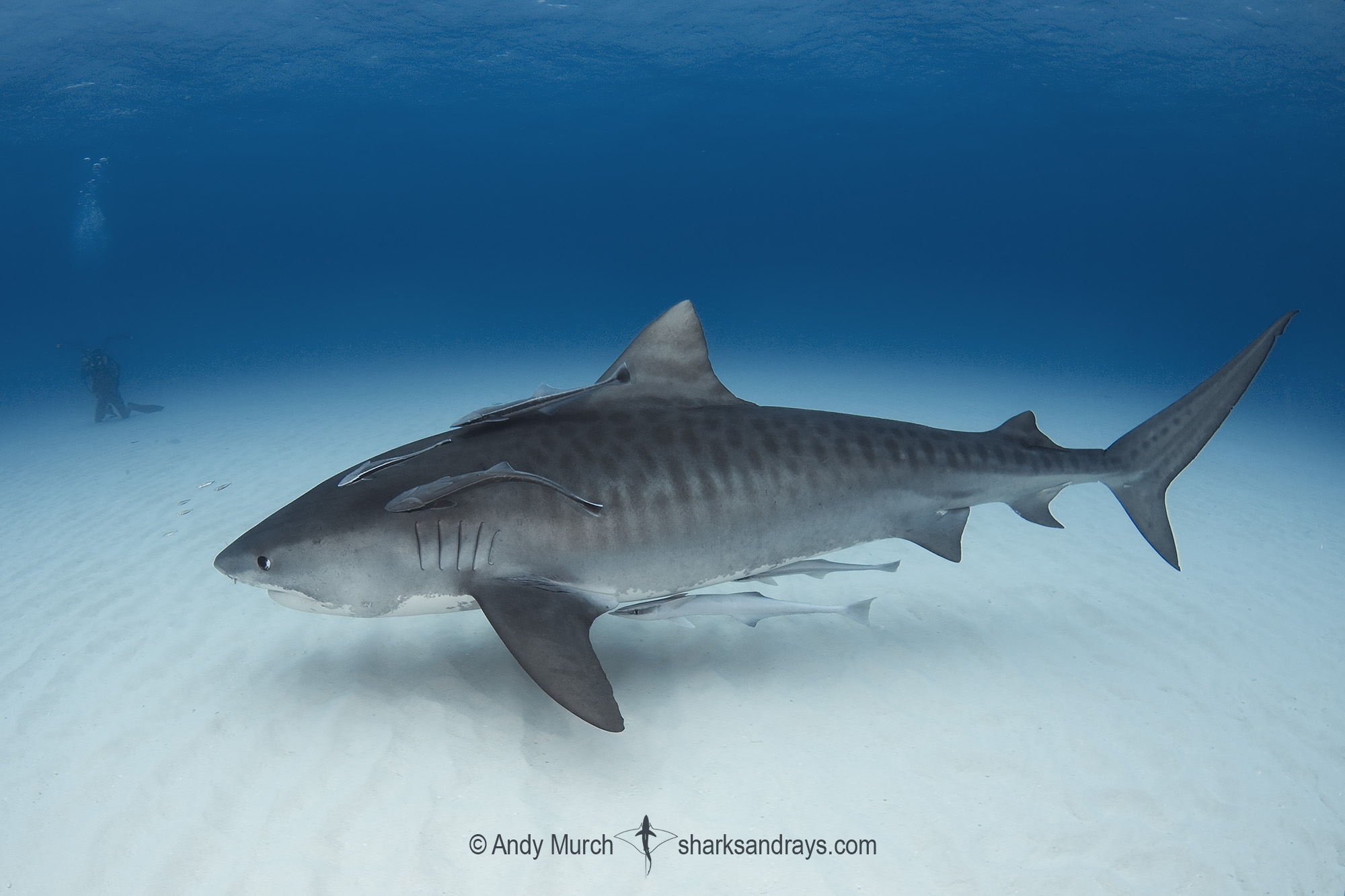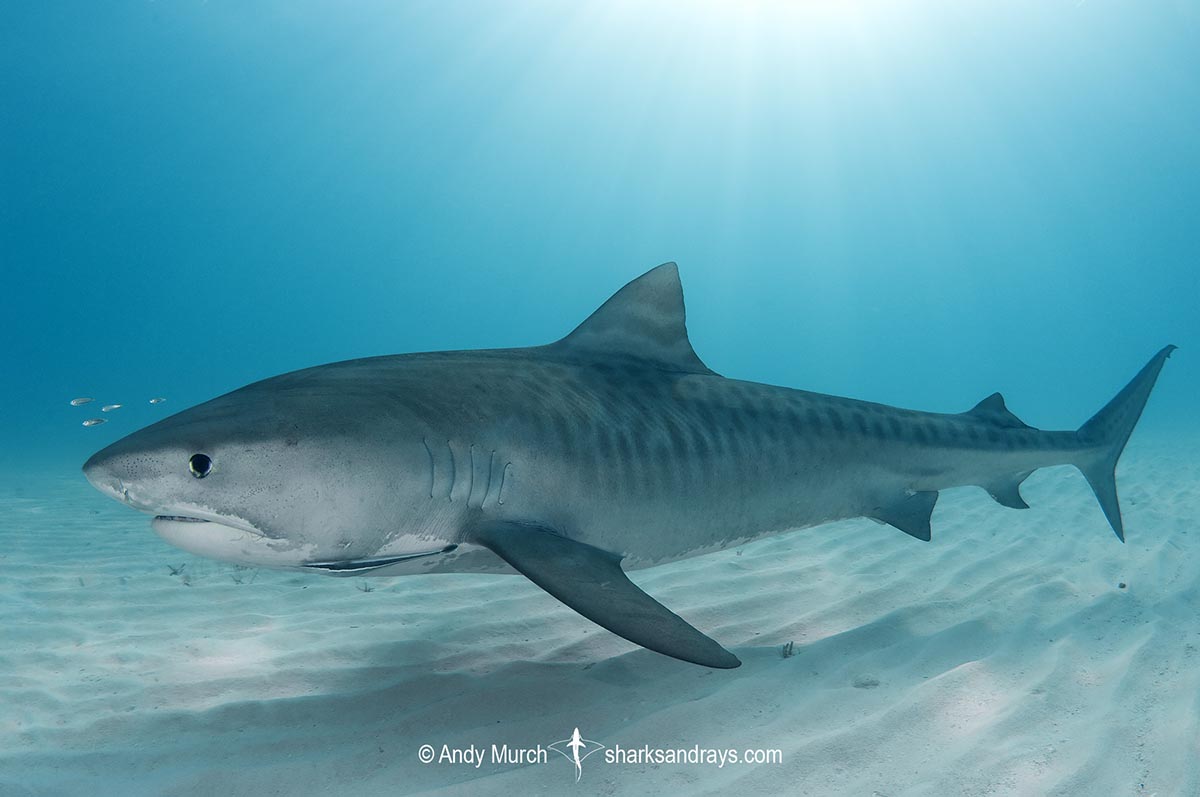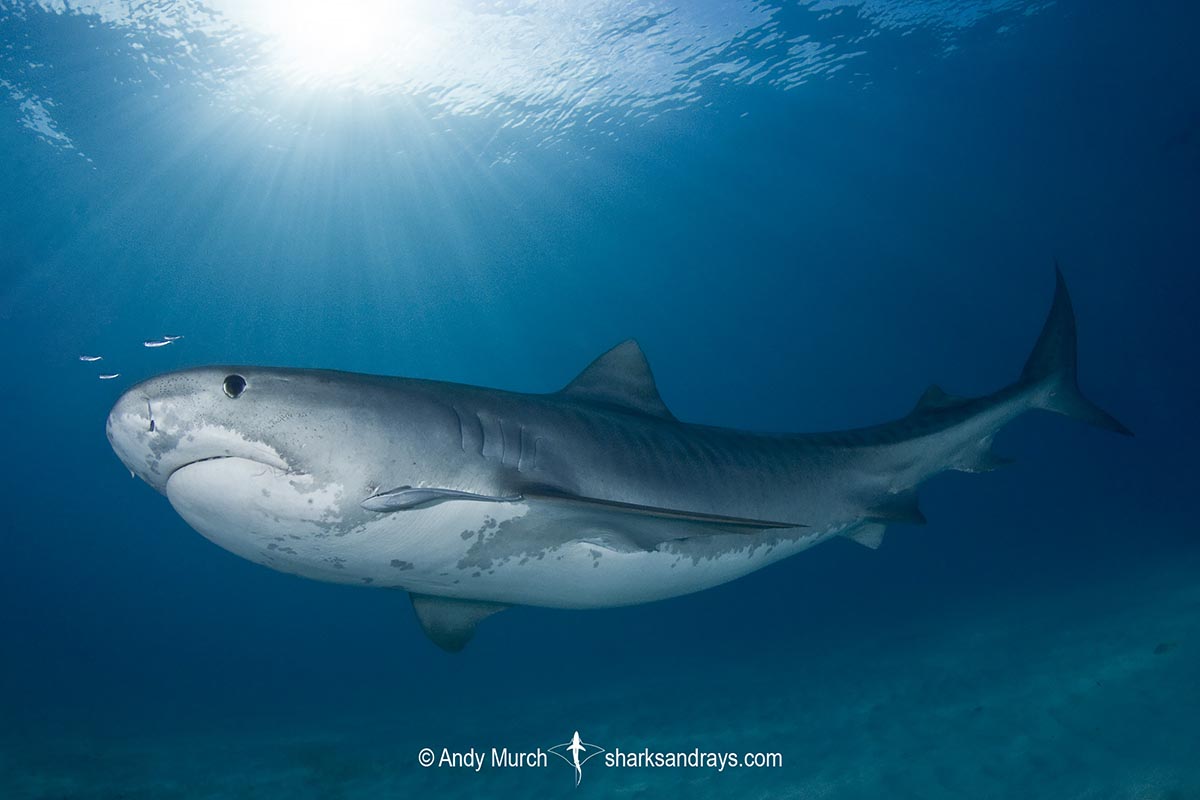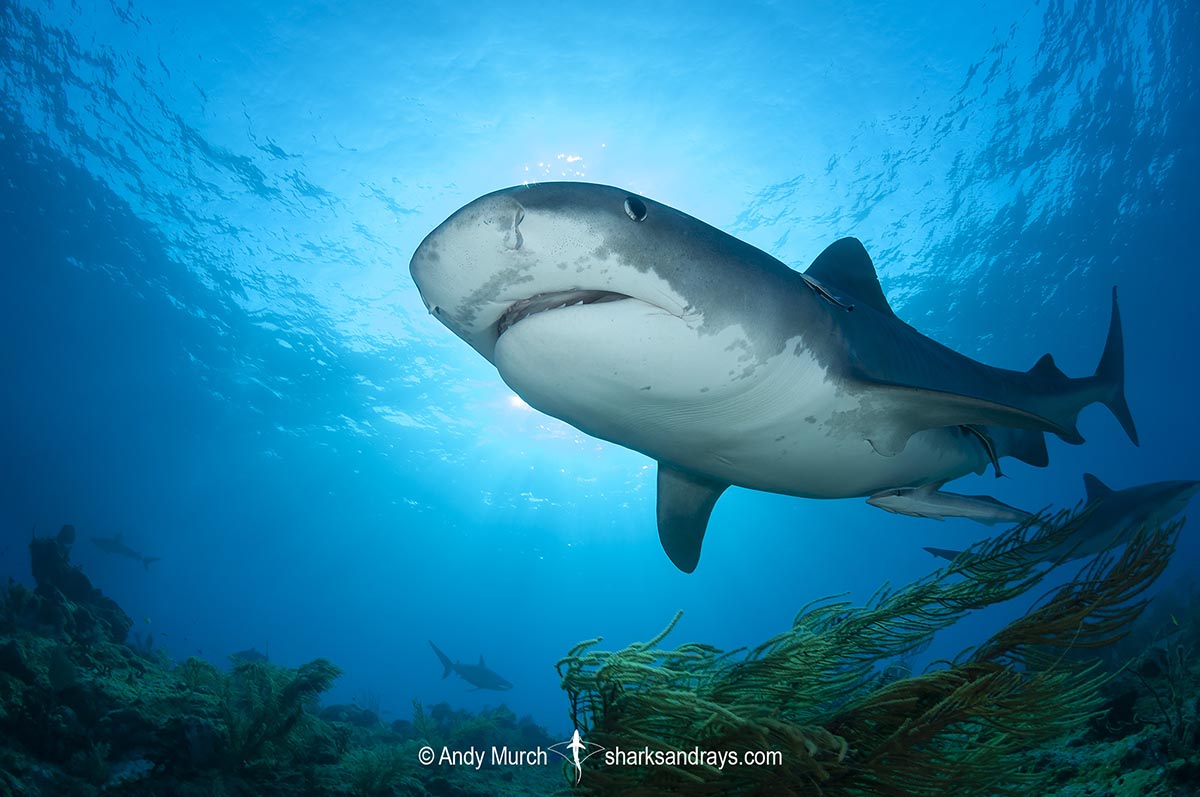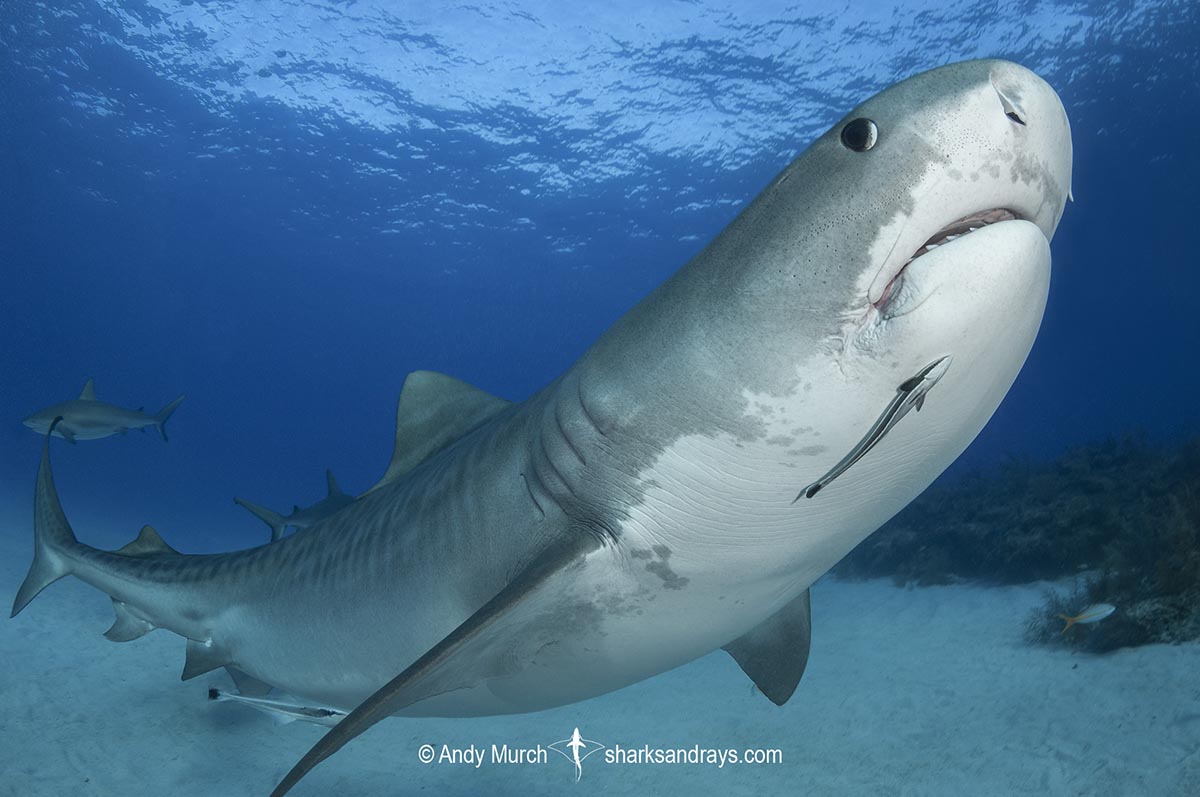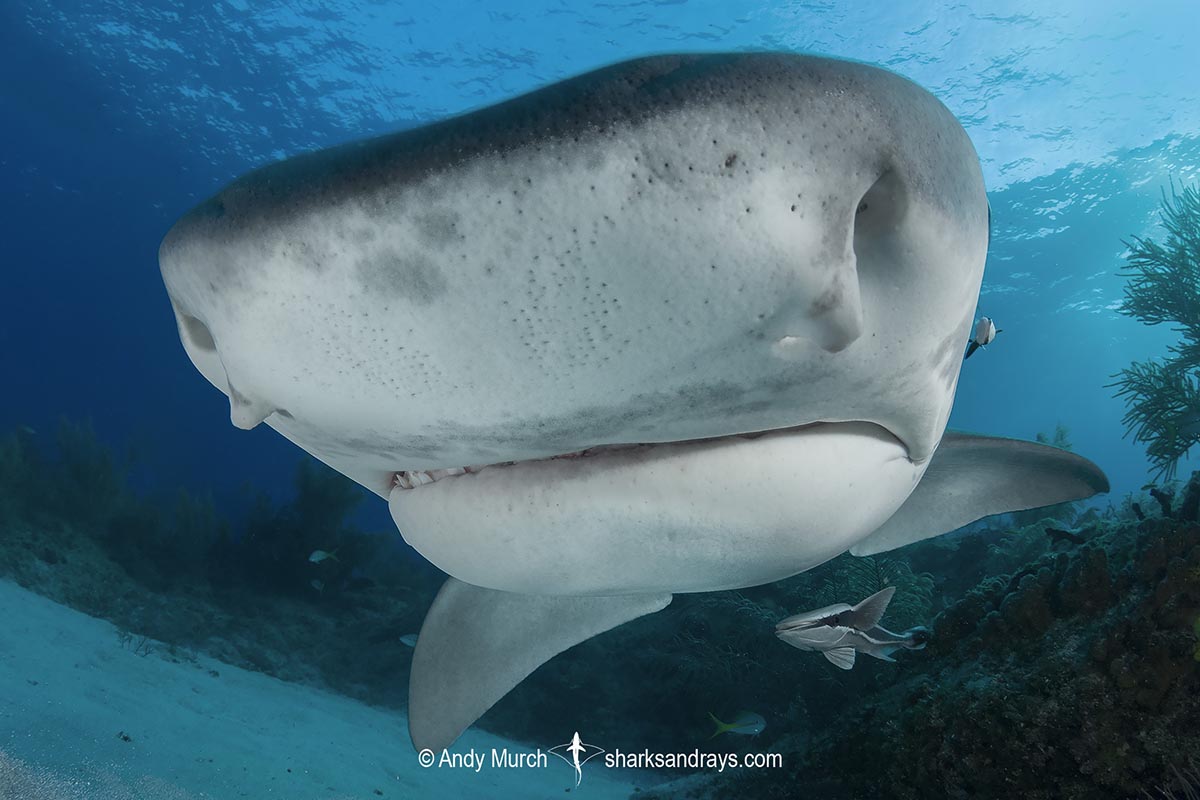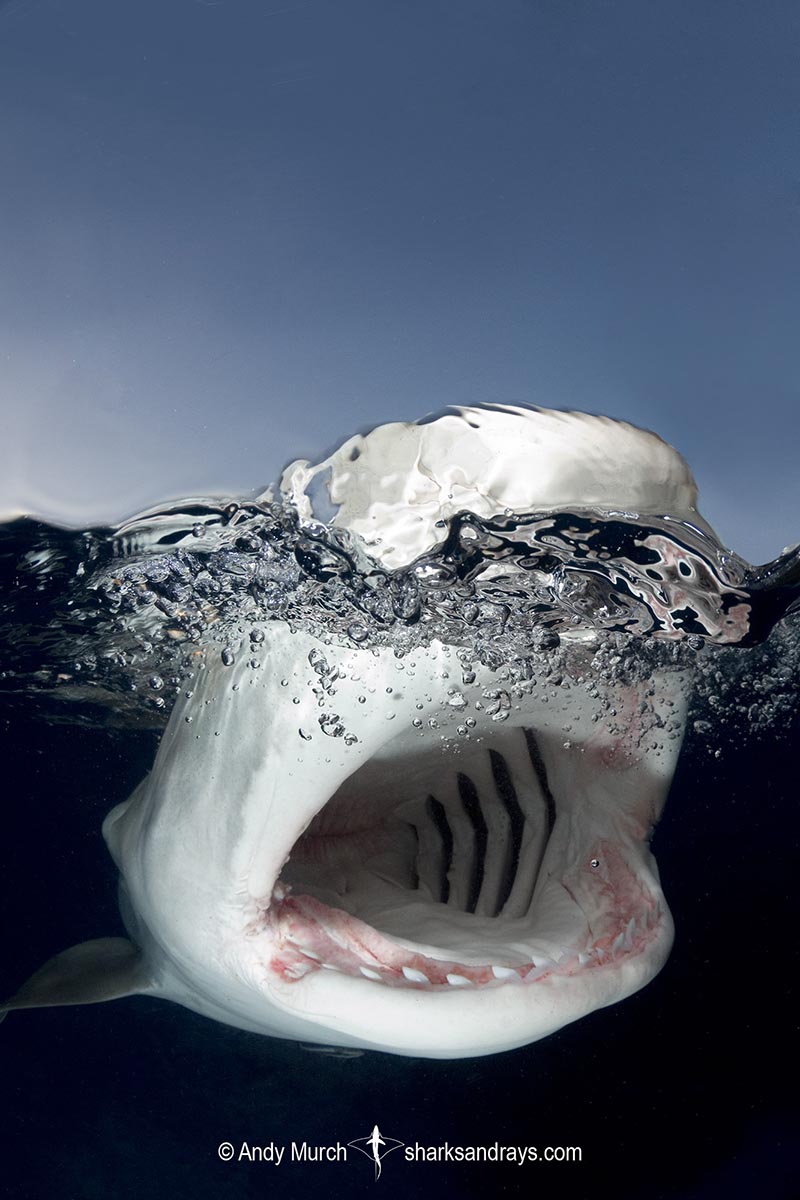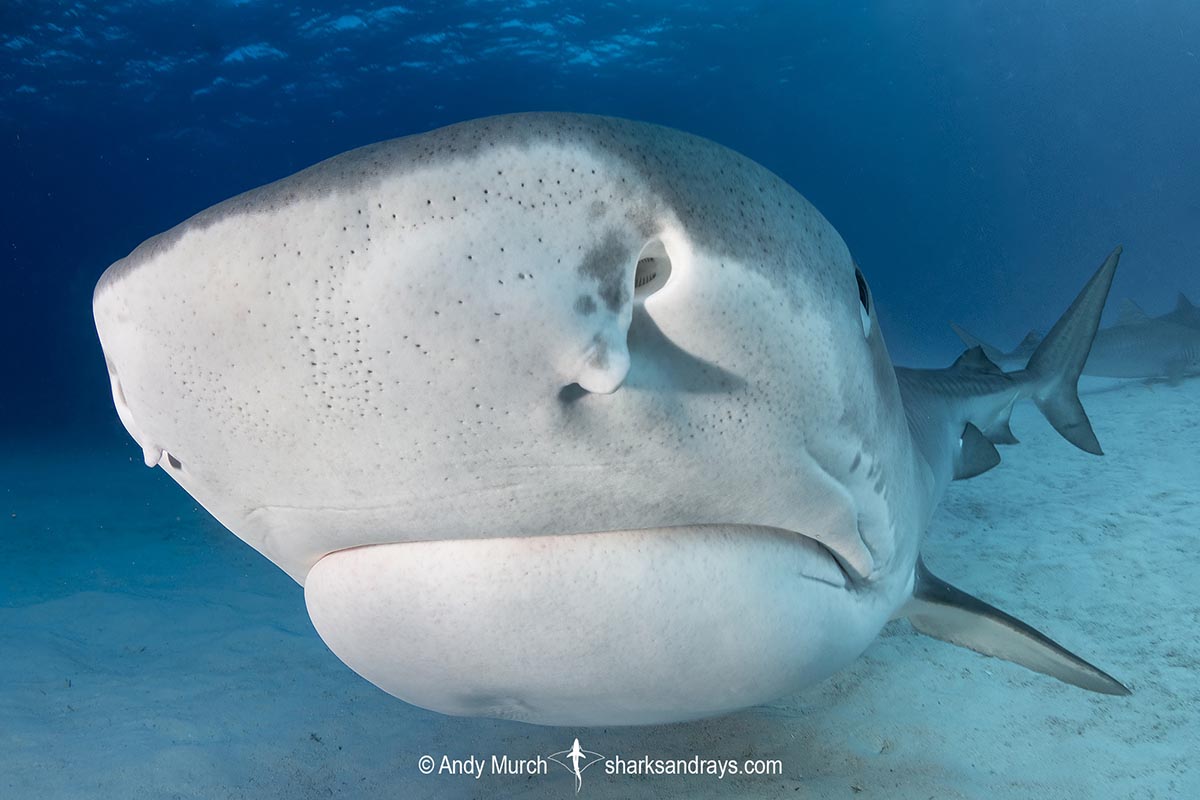Common names
Tiger Shark.
Binomial
Galeocerdo cuvier.
Synonyms
Carcharias fasciatus, Carcharias hemprichii, Galeocerda cuvier, Galeocerdo arcticus, Galeocerdo cuvieri, Galeocerdo fasciatus, Galeocerdo obtusus, Galeocerdo rayneri, Galeocerdo tigrinis, Galeocerdo tigrinus, Galeus cepedianus, Galeus maculatus, Squalus arcticus, Squalus cuvier.
Identification
Largest of the Carcharinid Sharks. Head large with a blunt, square snout. Long labial furrows around mouth. Small but noticeable spiracles behind eyes. Subtle dermal keels on caudal peduncle. Dorsal coloration variable; shades of charcoal-grey, greenish-grey, or brownish grey, with a pattern of dark irregular blotches or vertical stripes forming subtle bars. In juveniles the patterns appear much more spot-like and bold. Over time, the spots become bars but also fade. Extremely large individuals may have barely discernible markings.
Size
Maximum length 549cm, possibly shorter. There are a few records of larger tiger sharks but most are unverifiable. For example, in 1961 a renowned researcher named Fourmanoir mentions a photograph he received from M. Teisseyre of a female tiger shark from Indochina that was 7.4m long. However, the shark was not actually measured by any scientists. Considering the enormous size difference between this report and verified records of the largest accurately measured tiger sharks, it is very unlikely to be a credible account. Even the size listed above of 549cm is questionable. The report was sent in 1948 to Bigelow and Schroeder from Luis Howell-Rivero in Cuba. This shark may have been accurately measured but Mr Rivero also reported the largest white shark in the world; a record which has since been dismissed. With this in mind, the largest accurate record may be a 472cm tiger shark taken off Maroubra, NSW, Australia in 1936.
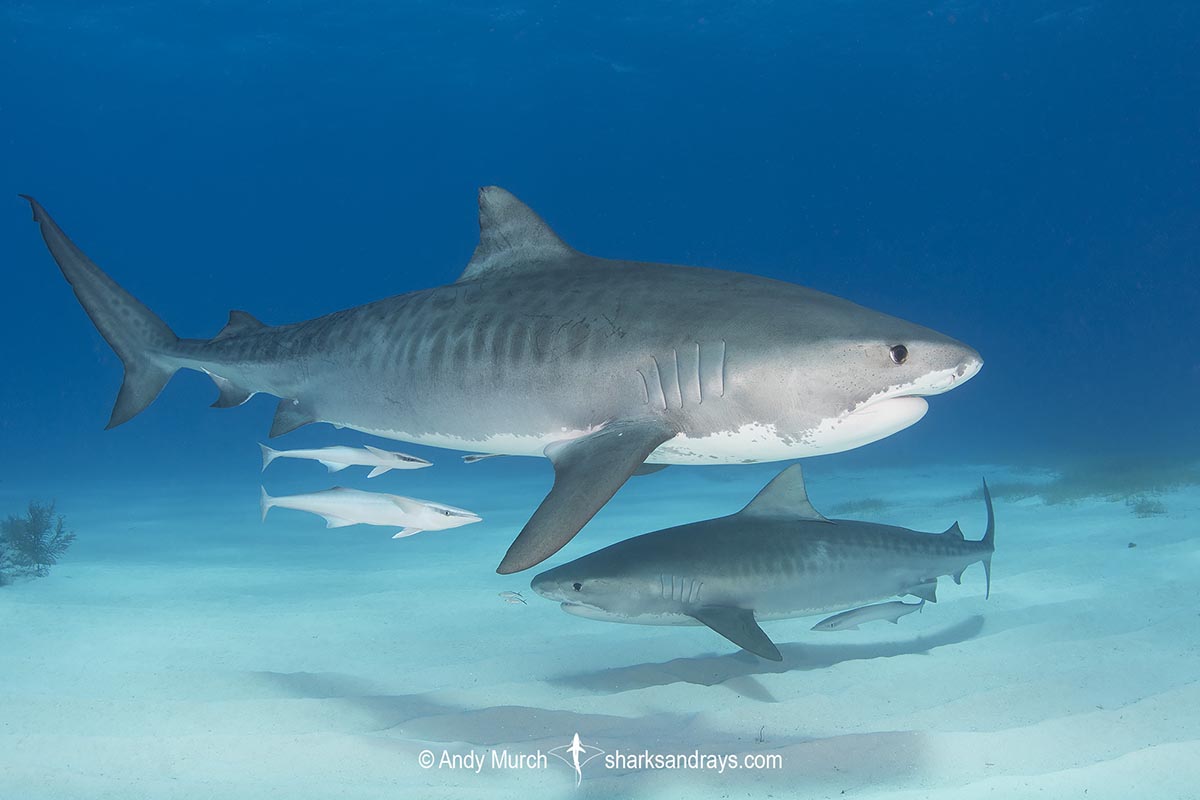
Conservation Status
NEAR THREATENED
Although the Tiger Shark (Galeocerdo cuvier) has large litters, its triennial reproductive cycle makes it very difficult for the population to recover from losses.
As well as being a targeted and bycatch component of artisanal and commercial fisheries in many areas, tiger sharks are also impacted by shark control programs (drum lines and shark nets) in countries such as Australia and South Africa. In North America the population appears to be relatively stable but significant declines have been reported from other areas. The overall tiger shark population is estimated to have decreased by 30% over the last three generation lengths and declines are expected to continue.
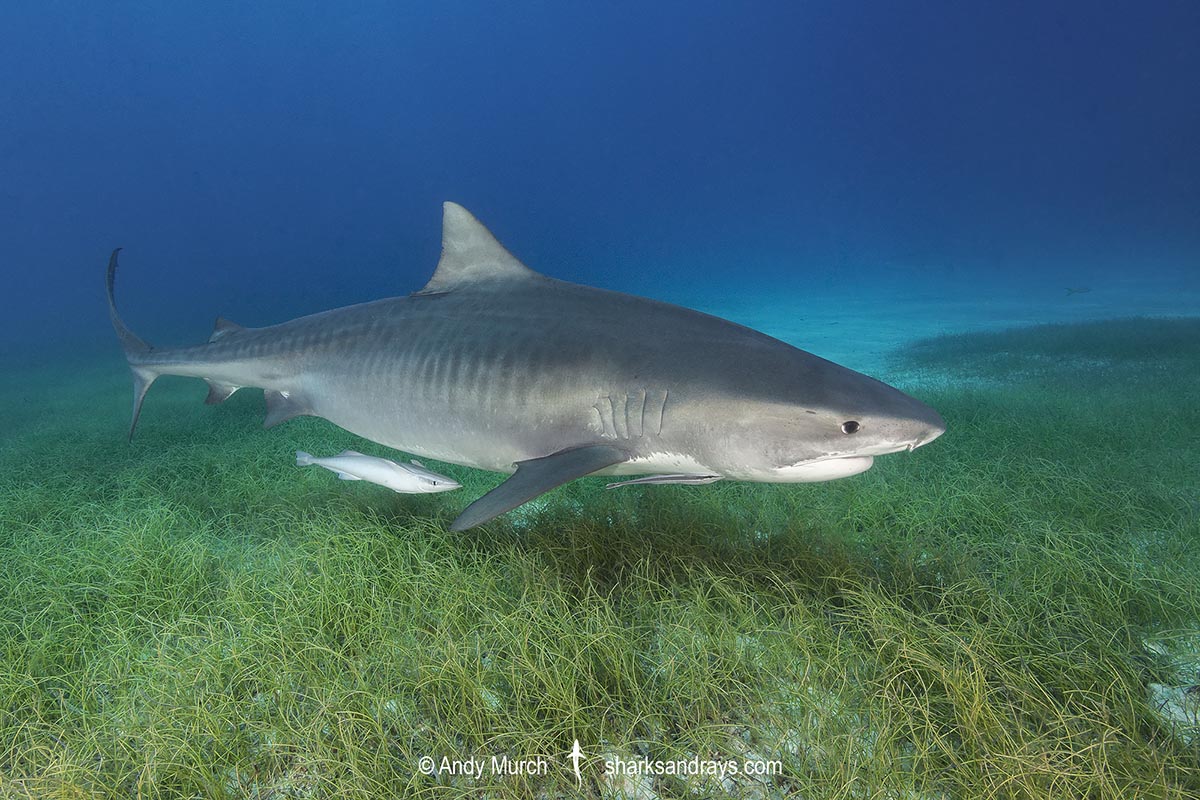
Habitat
Tropical/warm-temperate seas. Found from inshore estuarine environments to the edge of the continental shelf and around oceanic islands. Turbid or clear water. Often seen near coral reefs.
Generally in shallow water but recorded at 1,136m.
I have deployed baited deep camera systems that was visited by tiger sharks at 600m and 800m off of South Bimini Island.
Distribution
The tiger shark is extremely cosmopolitan along most tropical and warm-temperate coastlines and offshore islands.
Reproduction
The tiger shark is the only aplacental viviparous carcharinid. It has a yolk sac but does not develop a placental connection to the uterus. Embryos develop inside shells filled with a yellowish liquid. Jose Castro noted that embryos he examined all had partially everted stomachs. He speculated that they may be absorbing extra nutrients from this fluid, which would explain their large size at birth; larger than the nutrients from their yolk sac could realistically supply.
Diet
Tiger sharks have an extremely varied diet. They are known to eat bony fishes, sea turtles, sharks and rays, molluscs, and crustaceans. They are largely opportunistic hunters and scavengers, eating whatever is readily available at any given time.
Behavior
Some tiger sharks migrate over great distances, while others stay in one spot for most of the year. The availability of food is probably an important factor. There are records of tagged tigers traveling from the northeastern USA to Brazil.
Reaction to divers
Given their size, tiger sharks are often surprisingly wary around divers, even when food is introduced. In areas where they are habituated to divers such as at Tiger Beach, they are extremely nonchalant towards divers that are not carrying food.
CAUTION: Tiger Sharks have been implicated in numerous attacks in some areas, e.g. attacks on surfers and swimmers in Hawaii.
Diving logistics
There are now quite a few baited encounters with tiger sharks but none that compare to the reputation and reality of Tiger Beach in The Bahamas. TB is a phenomenon in its own right. Not a beach at all, Tiger Beach is a shallow sandy area (with no land in sight) on Little Bahama Bank. At one particular dive site with the Tiger Beach area named Fish Tales, it is not uncommon to see 4-12 tigers on a dive; sometimes even more.
The diving at TB is very shallow (7-15m) so the dives often last 90-120 minutes if you’re good on air. The visibility is generally pretty good too, so the photographic opportunities are exceptional.
Any time is good for tigers except for the middle of summer when the water is too warm and the big sharks leave the area. Winter probably gathers slightly more sharks than other times but winter storms can be a huge problem, with many trips being cut short or cancelled. We (Big Fish Expeditions) run our trips in April when there are still plenty of tigers in the area and the weather is generally excellent.
At Fuvahmulah Atoll in the Maldives, there is a relatively new tiger shark feed that seems to be reliable and gaining in popularity. I have not been there yet but the reviews sound very promising.
In Fiji, the bull shark feed at Beqa Lagoon sometimes attracts tiger sharks but not reliably and not in great numbers.
At Aliwal Shoal near Durban in South Africa, there is a tiger shark feed that is a bit hit and miss for tigers but worth doing if only for the excellent oceanic blacktip encounters.
Un-baited Tiger Sharks are randomly seen at numerous popular locations. In the eastern Pacific, they frequently make an appearance at San Benedicto Island in the Revillagigedo Archipelago, Mexico. And at Cocos Island in Costa Rica. Theoretically, these encounters are the results of curiosity but at Socorro (and maybe Cocos too) I have known of divemasters bringing a little bait, even though those activities are not permitted in those parks.
Similar species
Due to the tiger shark’s unusual markings, often enormous size, and blunt, square snout, it is unlikely to be misidentified in the field.

